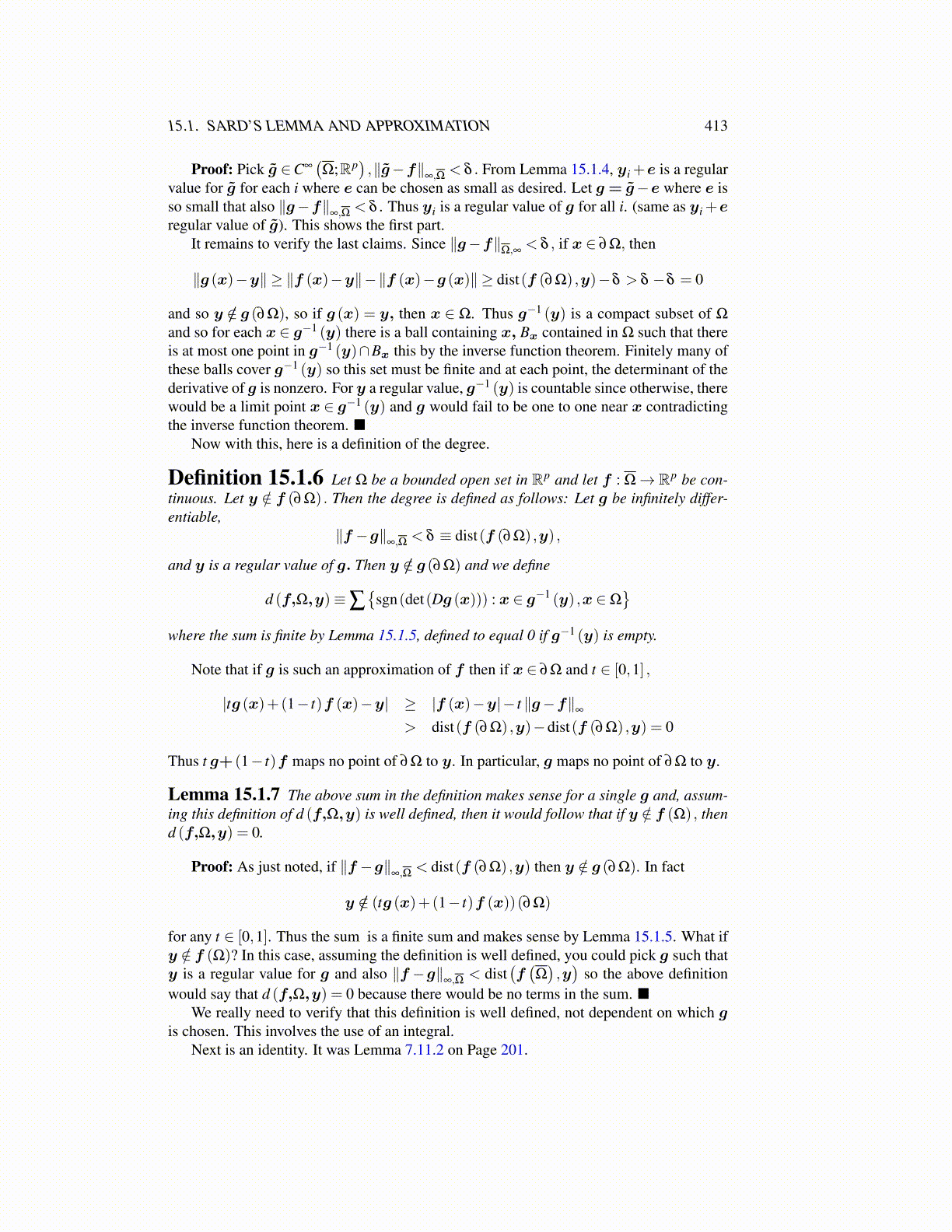
15.1. SARD’S LEMMA AND APPROXIMATION 413
Proof: Pick g̃ ∈C∞(Ω;Rp
),∥g̃−f∥
∞,Ω < δ . From Lemma 15.1.4, yi +e is a regularvalue for g̃ for each i where e can be chosen as small as desired. Let g= g̃−e where e isso small that also ∥g−f∥
∞,Ω < δ . Thus yi is a regular value of g for all i. (same as yi +eregular value of g̃). This shows the first part.
It remains to verify the last claims. Since ∥g−f∥Ω,∞ < δ , if x ∈ ∂Ω, then
∥g (x)−y∥ ≥ ∥f (x)−y∥−∥f (x)−g (x)∥ ≥ dist(f (∂Ω) ,y)−δ > δ −δ = 0
and so y /∈ g (∂Ω), so if g (x) = y, then x ∈ Ω. Thus g−1 (y) is a compact subset of Ω
and so for each x ∈ g−1 (y) there is a ball containing x, Bx contained in Ω such that thereis at most one point in g−1 (y)∩Bx this by the inverse function theorem. Finitely many ofthese balls cover g−1 (y) so this set must be finite and at each point, the determinant of thederivative of g is nonzero. For y a regular value, g−1 (y) is countable since otherwise, therewould be a limit point x ∈ g−1 (y) and g would fail to be one to one near x contradictingthe inverse function theorem. ■
Now with this, here is a definition of the degree.
Definition 15.1.6 Let Ω be a bounded open set in Rp and let f : Ω→ Rp be con-tinuous. Let y /∈ f (∂Ω) . Then the degree is defined as follows: Let g be infinitely differ-entiable,
∥f −g∥∞,Ω < δ ≡ dist(f (∂Ω) ,y) ,
and y is a regular value of g. Then y /∈ g (∂Ω) and we define
d (f,Ω,y)≡∑{
sgn(det(Dg (x))) : x ∈ g−1 (y) ,x ∈Ω}
where the sum is finite by Lemma 15.1.5, defined to equal 0 if g−1 (y) is empty.
Note that if g is such an approximation of f then if x ∈ ∂Ω and t ∈ [0,1] ,
|tg (x)+(1− t)f (x)−y| ≥ |f (x)−y|− t ∥g−f∥∞
> dist(f (∂Ω) ,y)−dist(f (∂Ω) ,y) = 0
Thus t g+ (1− t)f maps no point of ∂Ω to y. In particular, g maps no point of ∂Ω to y.
Lemma 15.1.7 The above sum in the definition makes sense for a single g and, assum-ing this definition of d (f,Ω,y) is well defined, then it would follow that if y /∈ f (Ω) , thend (f,Ω,y) = 0.
Proof: As just noted, if ∥f −g∥∞,Ω < dist(f (∂Ω) ,y) then y /∈ g (∂Ω). In fact
y /∈ (tg (x)+(1− t)f (x))(∂Ω)
for any t ∈ [0,1]. Thus the sum is a finite sum and makes sense by Lemma 15.1.5. What ify /∈ f (Ω)? In this case, assuming the definition is well defined, you could pick g such thaty is a regular value for g and also ∥f −g∥
∞,Ω < dist(f(Ω),y)
so the above definitionwould say that d (f,Ω,y) = 0 because there would be no terms in the sum. ■
We really need to verify that this definition is well defined, not dependent on which gis chosen. This involves the use of an integral.
Next is an identity. It was Lemma 7.11.2 on Page 201.